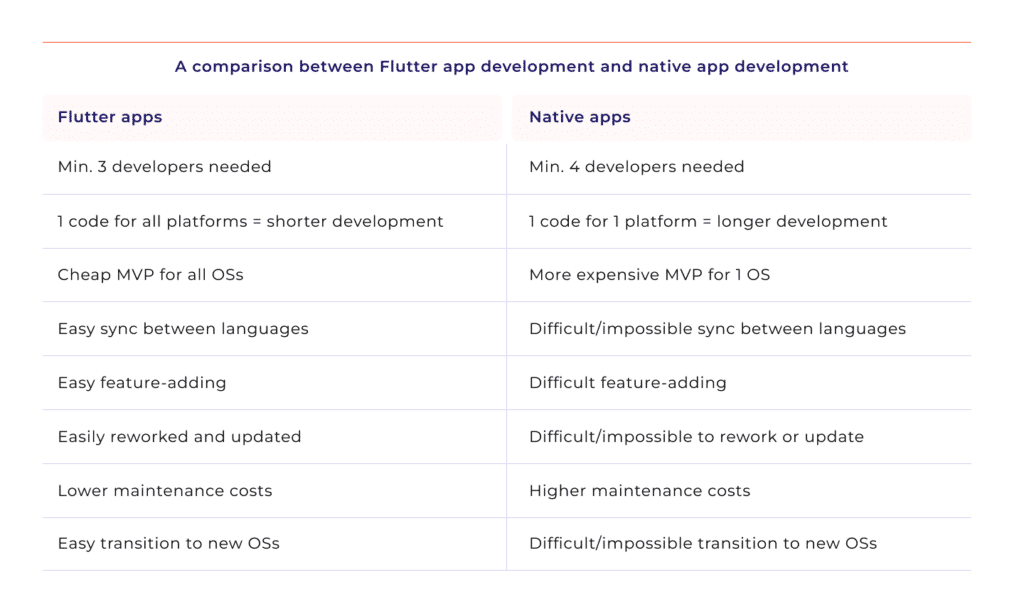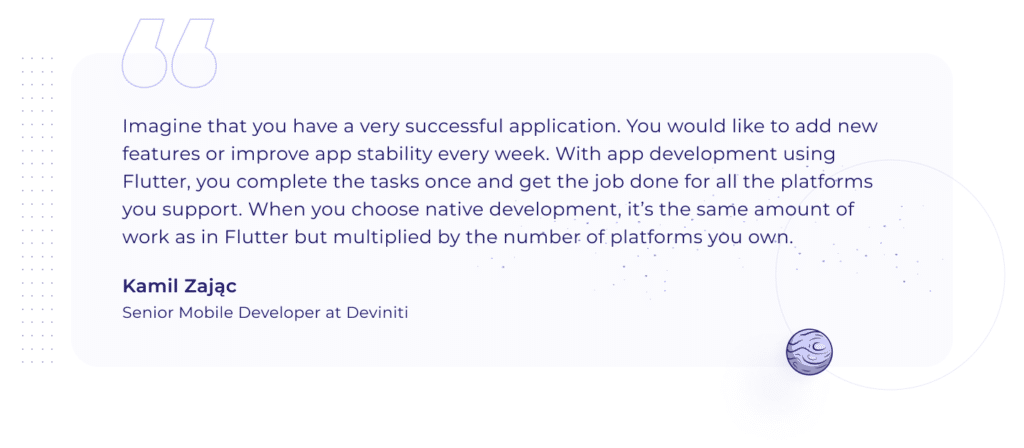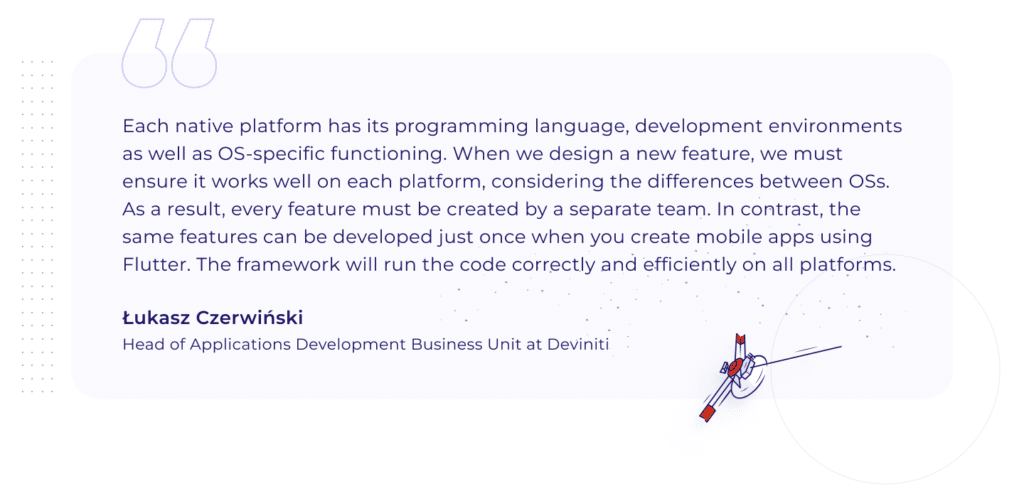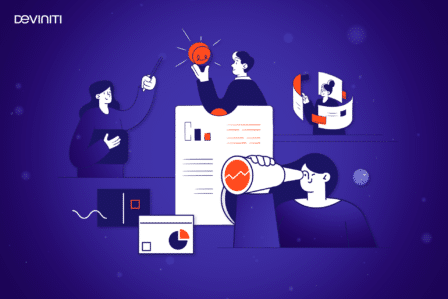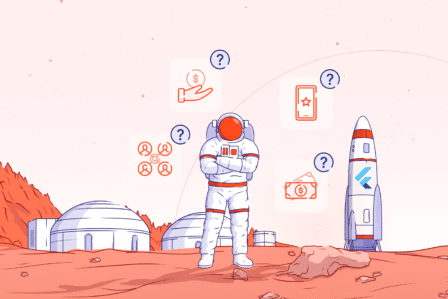Your business without a Flutter app – what are the consequences?
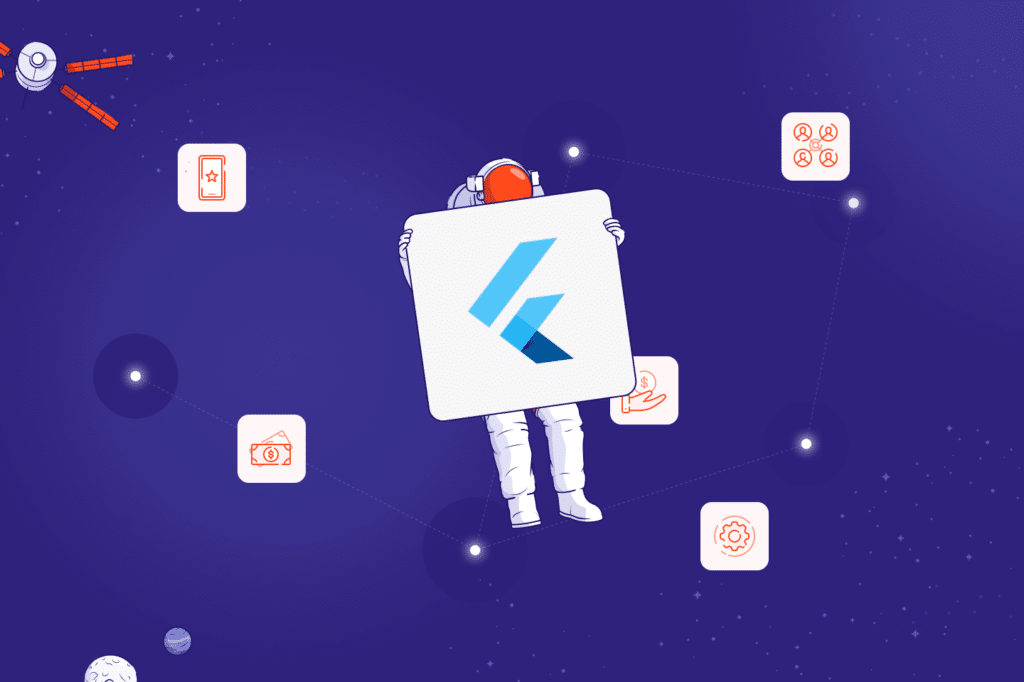
Nowadays many companies reach their customers via dedicated mobile or desktop applications. These apps are used for shopping, getting news, entertainment, and much more. The options mostly depend on your creativity… and budget. One of the best solutions for building apps is Flutter – a Software Development Kit by Google. Flutter brings so many possibilities to the table that your business greatly misses out when you don’t apply it. In this article, we will show you what consequences your business suffers if you don’t build a mobile app using Flutter.
Mobile development is a lengthy and costly process. Unless you are dealing with it on your own, it often involves deep cooperation between your company and a chosen development company. You usually present your expectations and analyze possible solutions offered by the contractor. Some decisions will be so crucial that they can either boost or sink your projects.
One such decision is having the right framework to develop your mobile app. If you decide to go for a cross-platform app development framework like Flutter, you can’t go wrong. This solution enables fast development as well as low costs and makes your application function on all mobile operating systems. The best course of action is to find an experienced Flutter app development company to carry out all the work.
On the other hand, when you select a native app development framework, you can’t blame anyone for the consequences. They will limit you by blocking your app’s expansion or its adherence to mobile app trends. Not to mention additional costs or the long time of such mobile development. Still in need of convincing? Let’s analyze the situation together and see what can happen if you turn down Flutter app development.
What are the consequences of choosing native apps over Flutter apps?
Higher staffing costs
For the sake of our example, let’s assume that you are commissioning a medium-sized project for an app. When you opt for mobile app development using Flutter, you can engage as few as three people in the process. When you choose a native app of equal size and versatility, you need at least four people. These are an iOS Developer, an Android Developer, a Web Developer, and a Backend Developer. Involving more employees on the development company’s side translates into a higher price for your application.
The developers will also spend more time on meetings and communication, thus ramping up working hours and the costs of your final product. An average hourly rate for a developer’s work in the USA amounts to USD 75-125. If you take the average of USD 100 and multiply this by the average working time required for a small app (about 20 man-days), you will get a cost of 16,000 USD. It goes beyond that sum when you consider larger applications (view the details). In the end, you will have to pay more for similar results.

Ready to dive into Flutter development?
Explore our awesome Flutter development services to get your own versatile and beautiful Flutter app!
Longer development time
Time is of the essence, especially in business. Your competition keeps looking for better ways to attract customers, including your customers. The sooner you can bring them to your side with a dedicated app, the better. Unfortunately, resigning from Flutter app development services means a longer development time. An analysis performed by DigiCode shows that creating native apps is around 20-50% slower in comparison to Flutter. Matilda Olsson proves that in Figure 9 of her scientific article – it takes longer to build a sample app with frameworks other than Flutter.

Applications created with more complex programming languages such as Java and Kotlin (for Android) or Swift and Objective-C (for iOS) take much more time. One skilled Flutter App Developer can make an app work with iOS, macOS, Android, or Windows. Native solutions need separate developers for each platform. Also, depending on the app’s intricacy, the developers must sometimes use mixtures of programming languages, resulting in more complicated development.
To make things worse, such applications require a Frontend Developer (a Web Developer, to be specific) for web application development, thus extending the development time. More people and advanced programming mean that you must postpone all your app-related campaigns for quite a while.
Problematic marketability
If you are unsure of your market, you can always consider creating a minimum viable product (MVP). This kind of app has a limited set of features meant for testing the very app concept. Creating a mobile app using Flutter provides desirable options for the quick and easy creation of an MVP. It’s possible thanks to special features like the reuse of the existing logic and UI elements in your web apps. On the other hand, native app frameworks are very difficult to manage even when it comes to a simple MVP. You can create your solution for just one platform, but this greatly limits your audience.
What is more, if you ever decided to go for all three operating systems, you would have to create an MVP on three different platforms from scratch. This would consume a lot of developers’ time and your money in comparison to the general Flutter app development cost. All these resources will go to waste when your proof of concept turns out to be wrong. Consequently, releasing even a simple MVP without Flutter costs a small fortune while providing limited market reach and a longer time to market.
Synchronization issues
As you already know, Flutter is a cross-platform application development framework. This means Flutter apps for all platforms share the same code and are easy to synchronize. However, when you want to perform this synchronization with a native app development framework. The process becomes close to impossible, and no development companies might be willing to do it.
Even if you manage to find a skilled software house, you will probably have to pay a small fortune. The bill might discourage you from such services for a long time. You might even consider having a native app created from scratch. Unfortunately, this will also come at a high cost.
Limited features
Businesses evolve the most when things start going well for them. You might have purchased an application some time ago. Now your target audience’s expectations can be different, so you need your app to have additional features. What now? When you create a mobile app using Flutter, you can use available extensions to get by. It’s much worse with many other frameworks, especially native ones. Once your application is ready, introducing new features becomes insurmountable.
You will often have to start over with your app. Nevertheless, recreating an app to add more features is problematic. It usually requires the same team to get the job done. Another team might take over the app, but this is a complicated and expensive process. In the end, neither option seems beneficial for your business. You can spend more money to redevelop the app or keep an outdated one and upset the users.
Obstacles for users
Apart from the functionalities, your users need only three things: app reliability, speed, and security. In simple words, the app should do what it’s meant to do, load fast and avoid endangering the users. Flutter apps seem to be ticking these boxes while many other frameworks don’t. Non-Flutter mobile apps are often quite heavy. Figure 8 from Matilda Olsson’s scientific article compares the code size and file code of her sample native and Flutter apps. The former ones are certainly larger.

Another issue is that desktop versions need a different web renderer incorporated into them to work properly. This might greatly slow down the operation of such apps. Tests and analyses from Code with Andrea mostly confirm this idea – non-Flutter apps seem quite slow.
Furthermore, in many cases, you need to restart your apps every time they change. This is because you can’t use hot reloading which is typical for Flutter. These combined disadvantages might hit two essential user expectations: reliability and speed. When your users must go through all this trouble of waiting and restarting, they are likely to resign from the app.
Higher maintenance costs
This case relates specifically to larger companies such as corporations. They often have a legacy code. It is a type of outdated code still in use due to its past reliability or company tradition. Legacy codes are very difficult to maintain and thus generate high costs. If your company has a legacy code, a large portion of your budget might be consumed to keep it running. Using non-Flutter frameworks won’t make it any better. You will have to deal with limited flexibility, so maintenance will require a lot of work.
If your app has been written in several programming languages, the duplicated features and codes will need more attention. Consequently, maintenance costs will rise even more. Your CFO or another person in charge of finances will be displeased. In the meantime, your budget will become highly unbalanced. You will have to maintain the existing old or complicated code instead of funding more meaningful projects. This will happen at the expense of small earnings from your outdated app.
Difficult transition
Technology is advancing – systems receive updates, and new ones are developed while others become obsolete. What does this mean for your company? If specific operating systems are no longer in use, all the applications meant for them will need recompilation. You must invest some money in this process to keep your apps running. The problem starts when your app uses non-Flutter development frameworks as they are difficult to support. Firstly, recompiling native apps is costly and difficult, so you need more time and money to get your app ready. Your customers might be left with an unsupported app. Then your competition can swoop in and take them over with a fully compatible app.
Secondly, Google is currently working on a new operating system called Fuchsia. You might want to transition to it, but native apps won’t receive support right away. As the new operating system slowly takes over, your competitors using Flutter apps might have more opportunities to attract early adopters and change them into loyal customers. If you want to take part in this new trend, you might be forced to build a new app from scratch to make it compatible with Fuchsia. This, in turn, means even higher costs – for creating an entirely new app or acquiring new customers.
Flutter – too valuable to neglect
Using native app development frameworks to build your company app can put your business at a serious disadvantage. You will have to pay more and wait longer for the completion of your app as well as its improvements. Your application is also likely to quickly become outdated. Eventually, your customers might grow tired of the complications and go to your competition with better solutions. When you switch to Flutter app development, you can act faster to keep your customers and save more money on growing your company. Flutter makes your business more adaptable to the never-ending market evolution. Many companies have already decided to invest in Flutter apps. Among the larger ones, you can find Google (obviously), eBay, Philips, or Groupon. Perhaps you would like to join these tycoons and create a unique opportunity for your company. It will certainly be worth your time!
Join the tycoons! Find your Flutter developer!
Your company’s success starts with the right app choices. Going for a Flutter app is the first step, and the second is finding the right Flutter developer. Read our next article to learn how to do it!
